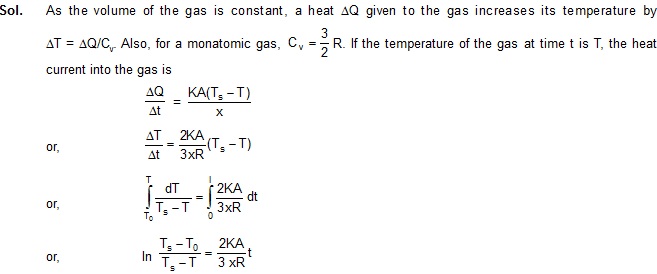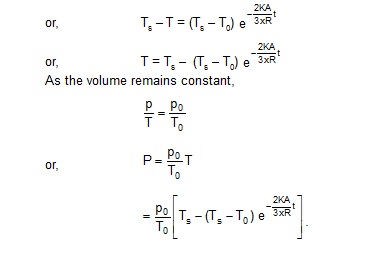Solved Examples
EXAMPLE 28.1
One face of a copper cube of edge 10 cm is maintained at 1000 C and the opposite face is maintained at 00 C. All other surfaces are covered with an insulating material.Find the amount of heat flowing per second through the cube. Thermal conductivity of copper is 385 W/m– 0 C.
Sol.
The heat flows from the hotter face towards the colder face. The area of cross–section perpendicular to the heat flow is
A = ( 10 cm ) 2
The amount of heat flowing per second is

EXAMPLE 28.2
Find the thermal resistance of an aluminimum rod of length 20 cm and area of cross–section 1 cm2 . The heat current is along the length of the rod . Thermal conductivity of aluminium = 200 W/m–K.
Sol.
The thermal resistance is

EXAMPLE 28.3
The light from the sun is found to have a maximum intensity near the wavelength of 470 nm.Assuming that the surface of the sun emits as a blackbody, calculate the temperature of the surface of the sun.

EXAMPLE 28.4
A blackbody of surface area 10 cm 2 is heated to 1270 C and is suspended in a room at temperature 270 C. Calculate the initial rate of loss of heat from the body to the room.

EXAMPLE 28.5
A liquid cools from 700 C to 600 C in 5 minutes. Calculate the time taken by the liquid to cool from 600 C to 500 C , if the temperature of the surrdounding is constant at 300 C.
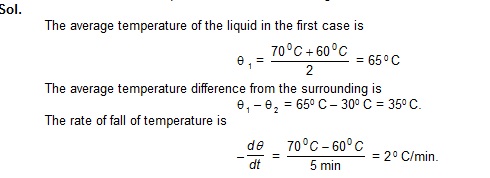
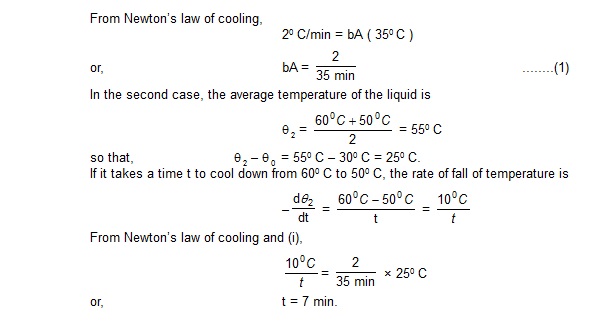
Questions for Short answer
![]()
2. Does a body at 20ºC radiate in a room, where the room temperature is 30ºC ? If yes, why does its temperature not fall further ?
3. Why does blowing over a spondful of hot tea cool it ? Does evaporation play a role ? Does radiation play a role ?
4. On a hot summer day we want to cool our room by opening the refrigerator door and closing all the windows and doors. Will the process work ?
5. On a cold winter night you are asked to sit on a chair. Would you like to choose a metal chair or a wooden chair ? Both are kept in the same lawn and are at the same temperature.
6. Two identical metal balls one at T1 = 300 K and the other at T2 = 600 K are kept at a distance of 1m in vaccum. Will the temperature equalise by radiation ? Will the rate of heat gained by the colder sphere be proportional to T24 – T14 as may be expected from the Stefan’s law ?
7. An ordinary electric fan does not cool the air, still it gives comfort in summer. Explain.
8. The temperature of the atmosphere at a high altitude is around 500ºC. Yet an animal there would freeze to death and not boil. Explain.
9. Starting in the sun is more pleasant on a cold winter day than standing in shade. Is the temperature of air in the sun considerably higher than that of the air in shade ?
10. Cloudy nights are warmer than the nights with clean sky. Explain.
11. Why is a white dress more comfortable than a dark dress in summer ?
Objective - I
1. The thermal conductivity of a rod depends on
(A) length (B) mass (C) area of cross-section (D) material of the rod
2. In a room contaning air, heat can go from one place to another
(A) by conduction only (B) by convection only (C) by radiation only (D) by all the three modes
3. A sloid at temperature T1 is kept in an evacuated chamber at temperature T2 > T1.
The rate of increase of temperature of the body is proportional to -
(A) T2 - T1 (B) T22 - T12 (C) T23 - T13 (D) T24 - T14
4. The thermal radiation emitted by a body is proportional to Tn where T is its absolute temperature.
The value of n is exactly 4 for -
(A) a blackbody (B) all bodies (C) bodies painted balck only (D) polished bodies only
5. Two bodies A and B having equal surface area are maintained at temperatures 10oC.
The thermal radiation emitted in a given time by A and B are in the ratio -
(A) 1 : 1.15 (B) 1 : 2 (C) 1 : 4 (D) 1 : 16
6. One end of a metal rod is kept in a furnace. In steady state, the temperature of the rod
(A) increases (B) decreases (C) remains constant (D) is nonuniform
7. Newton’s law of cooling is a special case of
(A) Wien’s displacement law (B) Kirchoff’s law
(C) Stefan’s law (D) Planck’s law
8. A hot liquid is kept in a big room. Its temperature is plotted as a funcation of time.
Which of the following curves may represent the plot ?
(A) a (B) c (C) d (D) b
9. A hot liquid is kept in a big room. The logarithm of the numerical value of the temperature difference between
the liquid and the room is plotted against time. The plot will be very nearly -
(A) a straight line (B) a circulat arc (C) a parbola (D) an ellipse
10. A body cools down from 65°C to 60°C in 5 minutes. It will cool down from 60°C to 55°C in
(A) 5 minutes (B) less than 5 minutes (C) more than 5 minutes
(D) less than or more than 5 minutes depending on whether its mass is more than or less than 1 kg.
Objective - II
1. One end of a metal rod is dipped in boiling water and the other is dipped in melting ice.
(A) All parts of the rod in thermal equilibrium with each other
(B) We can assign a temperature to the rod.
(C) We can assign a temperature to the rod after steady state is reached
(D) The state of the rod does not change after steady state is reached.
2. A blackbody does not :
(A) emit radiation (B) absorb radiation (C) reflect radiation (D*) refract radiation
3. In summer, a mild wind is often found on the shore of a calm river. This is caused due to
(A) difference in thermal conductivity of water and soil (B) convection currents
(C) conduction between air and the soil (D) radiation from the soil
4. A piece of charcoal and a piece of shining steel of the same area are kept for long time in an open lawn in bright sun.
(A) The steel will absorb more heat than the charcoal.
(B) The temperatuer of the steel will be higher than that of the charcoal.
(C) If the both are picked up by bare hands, the steel will be felt hotter than the charcoal
(D) If the two are picked up from the lawn and kept in a cold chamber, the charcoal will lose heat at a faster rate than the steel
5. A heated body emits radiation which has maximum intensity near the frequency v0. The emissivity of the material is 0.5. If the absolute temperature of the body is doubled
(A) the maximum intensity of radition will be near the frequency 2v0
(B) the maximum intensity of radiation will be near the frequency v0/2
(C) the total energy emitted will increase by a factor of 16
(D) the total energy emitted will increase by a factor of 8
6. A solid sphere and a hollow sphere of the same material and of equal radii are heated to the same temperature.
(A) Both will emit equal amount of radiation per unit time in the beginning
(B) Both will absorb equal amount of radiation from the surrounding in the beginning
(C) The initial rate of cooling will be the same for the two spheres
(D) The two spheres will have equal temperatures at any instant.

All the terms on RHS are same for both spheres except mass "m". ( Solid and hollow)
Hence dT/dt is different for both.
Hence (C) and (D) are wrong.
Worked Out Examples
1. The lower surface of a slab if stone of face-area 3600 cm2 and thickness 10 cm is exposed to steam at 100ºC. A block of ice at 0ºC rests on the upper
surface of the slab 4.8g of ice melts in one hour. Calculate the thermal conductively of the stone. Latent heat of fusion of ice = 3.36 × 105 J/kg.
Sol. The amount of heat transferred through the slab to the ice in one hour is
Q = (4.8 × 10–3kg) × (3.36 × 105 J/kg)
= 4.8 × 336 J.
Using the equation

or, K = 1.24 × 10–3 W/m–ºC.
2. An ice box made of 1.5 cm thick styrofoam has dimensions 60 cm × 60 cm × 30 cm. It contains ice at 0ºC and is keot in a room at 40ºC.
Find the rate at which the ice is melting. Latent heat of fusion of ice = 3.36 × 105J/kg. and thermal conductively of styrofoam = 0.04 W/m–ºC.
Sol. The total surface area of the walls
= 2(60 cm × 60 cm + 60 cm × 30 cm + 60 cm × 30 cm)
= 1.44 m2.
The thickness of the walls = 1.5 cm = 0.015 m.
The rate of heat flow into the box is
![]()
=(0.04 W / moC) (1.44m2)(40oC)/ 0.015m = 154W
The rate in which the ice melts is
= 154W/ 3.36 x 105 J/kg = 0.46 g/s.
3. A colosed cubical box is made of perfectly insulating material and the only way for heat to enter or leave the box is through two solid
cylindrical metal plugs, each of cross-sectional area 12 cm2 and length 8 cm fixed in the opposite walls of the box. The outer surface of one
plug is kept at a temperature of 100ºC while the outer surface of the other plug is maintained at a temperature of 4ºC. The thermal conductivity
of the material of the plug is 2.0 W/m— ºC. A source of energy generating 13W is enclosed inside the box assuming that it is the same at all
points on the inner surface..
Sol.
The situation is shown in figure. Let the temperature inside the box be q. The rate at which heat enters the box through the left plug is
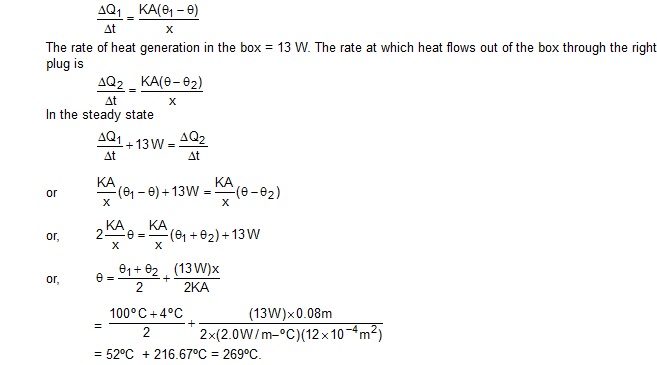
4. A bar of copper of length 75 cm and a bar of steel of length 125 cm are joined together end. Both are of circular cross-section
with diameter 2 cm. The free ends of the copper and the steel bars are mintained at 100ºC and 0ºC respectively. The curved surface
of the bars are thermally insulated. What is the temperature of the copper-steel junction ? What is the amount of heat transmitted per
unit time across the junction? Thermal conductivity of copper is 386 J/m-s-ºC and that of steel is 46ºJ/m-s-ºC.
Sol.
The situtation is shown in figure. Let the temperature at the junction be q (on Celsius scale). The same heat current passes through
the copper and the steel rods. Thus ,
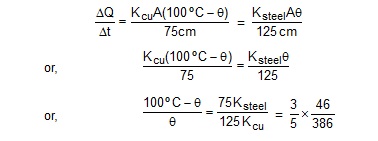
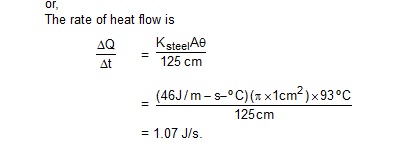
5. Two parallel plates A and B are joined together to form a compound plate (figure). The thicknesses of the plates are 4.0 cm and
2.5 cm respectively and the area of cross-section is 100 cm2 for each plate. The thermal conductivities are KA = 200 W/m-ºC for
the plate A and KB = 400 W/m-ºC for the plate B. The outer surface of the plate A is maintained at 100ºC and the outer surface
of the plate B is maintained at 0ºC. Find
(a) the rate of heat flow through any cross-section,
(b) the temperature at the interface and
(c) the equivolent thermal conductivity of the compound plate.
Sol. (a) Let the temperature of the interface be q.
The area of cross-section of each plate is A = 100 cm3 = 0.01 m2. The thickness are xA = 0.04 m and xB = 0.025 m.
The thermal resistance of the plate A is
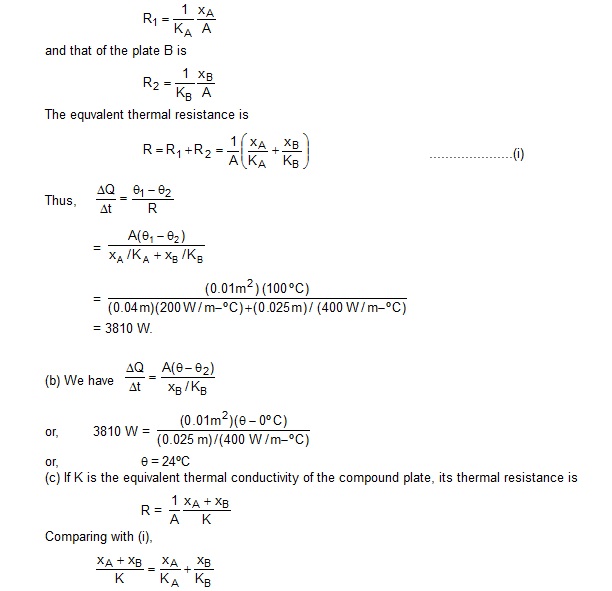

6. A room has a 4 m × 4 m × 10 cm concrete roof (K = 1.26 W/m-ºC). At some instant, the temperature outside is 46ºC and that inside is 32ºC.
(a) Negalecting convection, calculate the amount of heat flowing per second into the room through the roof.
(b) Bricks ( K = 0.65 W/m-ºC) of thickness 7.5 cm are laid down on the roof. Calculate the new rate of heat flow under the same temperature conditions.
Sol. The are of the roof
= 4 m × 4 m = 16 m2.
The thickness x = 10 cm = 0.10 m.
(a) The thermal resistance of the roof is
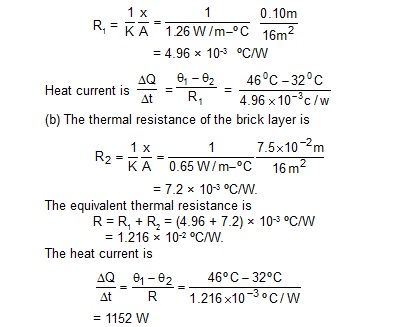
7. An electric heater is used in a room of total wall area 137 m2 to maintain a temperature of 20ºC inside it, when the outside temperature is -10ºC.
The walls have three different layers of materials. The innermost layer is of wood of thickness 2.5 cm, the middle layer is of cement of thickness
1.0 cm and the outermost layer is of brick of thickness 25.0 cm. Find the power of the electric heater. Assume that there is no heat loss through the
floor and the ceiling. The thermal conductivities of wood, cement and ‘brick are 0.125W/m-ºC, 1.5 W/m-ºC and 1.0 W/m-ºC respectively.
Sol. 
The situation is shown in figure. The thermal resistance of the wood, the cement and the brick layers are
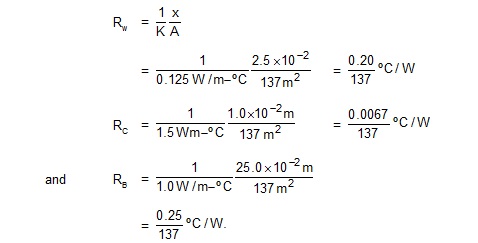

The heater must supply 9000 W to compenstate the outflow of heat.
8. Three rods of material x and three of material y are connected as shown in figure. All the rods are indentical in length and
cross-sectional area. If the end A is maintained at 60ºC and the junction E at 10ºC, calculate the temperature of the junction B.
The thermal conductivity of x is 800 W/m-ºC and that of y is 400 W/m-ºC.
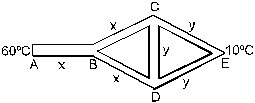
Sol. It is clear from the symmetry of the figure that the points C and D are equivalent in all respect and hence, they are at the same temperature,
say q. No heat will flow through the rod CD. We can, therefore, neglect this rod in further analysis.
Let l and A be the length and the area of cross-section of each rod. The thermal resistance of AB BC and BD are equal. Each has a value

As the rod CD has no effect, we can say that the rods BC and CE are joined in series. Their equivalent thermal resistance is
R3 = RBC + RCE = R1 + R2
Also, the rods BD and DE together have an equivalent thermal resistance R4 = RBD + RDE = R1 + R2.
The resistances R3 and R4 are joined in parallel and hence their equivalent thermal resistance is given by

Figure shows the sucessive steps in this reduction.



9. A rod CD of thermal resistance 5.0 K/W is joined at the middle of an identical rod AB as shown in figure.
The ends A, B and D are maintained at 100ºC, 0ºC and 25ºC respectively. Find the heat current in CD.
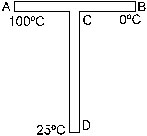
Sol. The thermal resistance of AC is equal to that of CD and is equal to 2.5 K/W. Suppose, the temperature at C is
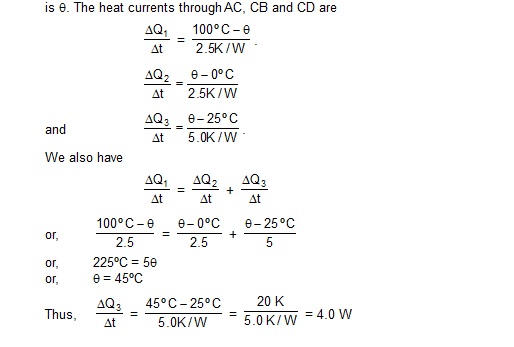


Thus
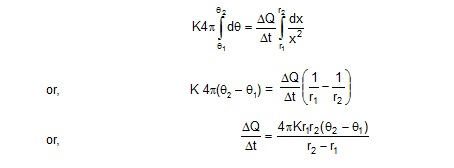
11. On a cold winter day, the atmospheric temperature is –q (on Celsius scale) which is below 0ºC. A cylindrical drum
of height h made of a bad conductor is completely filled with water at 0ºC and is kept outside without any lid.
Calculate the time taken for the whole mass of water to freeze. Thermal conductively of ice is K and its latent heat of fusion is L.
Neglect expansion of water on freezing.
Sol.
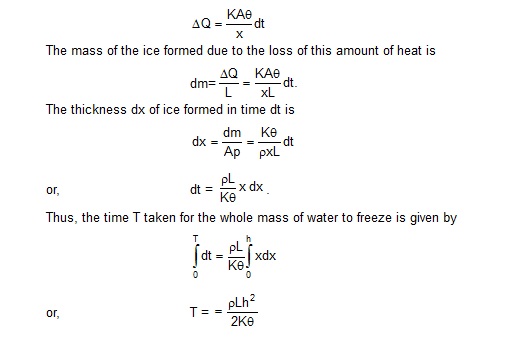


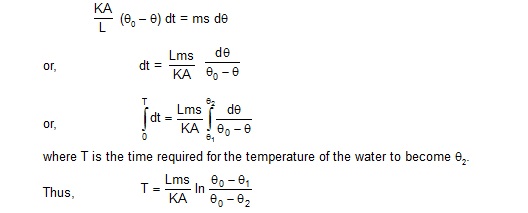
13. One mole of an ideal monatomic gas is kept in a rigid vessel. The vessel is kept inside a steam chamber whose temperature is 97ºC,
Initially, the temperature of the gas is 5.0ºC. The walls of the vessel have an inner surface of area 800 cm2 and thickness 1.0 cm.
If the temperature of the gas increases to 9.0ºC in 5.0 seconds, find the thermal conductivity of the material of the walls.
Sol. The initial temperature difference is 97ºC – 5ºC = 92ºC and at 5.0 s the temperature difference becomes 97ºC – 9ºC = 88ºC.
As the change in the temperature difference is small, we work with the average temperature difference
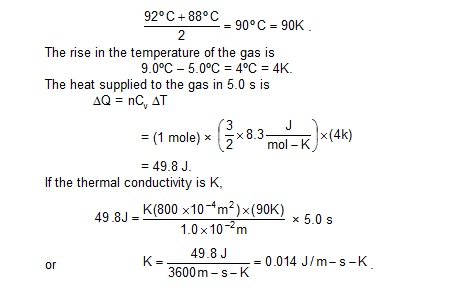
14. A monatomic ideal gas is contained in a rigid container of volume V with walls of total inner surface area A, thickness x and thermal
conducticity K. The gas is at an initial temperature T0 and pressure p0. Find the pressure of the gas as a function of time if the
temperatureof the surrounding air is T0. All temperatures are in absolute scale.
